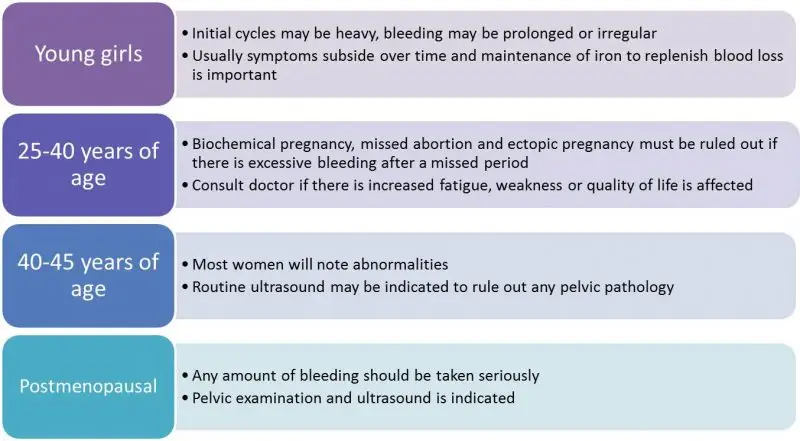Abnormal menstrual bleeding is a common health problem which almost every woman faces during her lifetime. It can be excessive bleeding during cycles or prolonged bleeding or shortened cycles. Such abnormal and excessive bleeding leads to fatigue/anxiety in the woman and impairs quality of life.
In young girls:
- Cycles in young girls can be initially heavy to begin with.
- Bleeding can be prolonged, heavy or irregular.
- There can be dysmenorrhea significant enough to interfere with the quality of life.
- This problem generally subsides over a period of time – few months to couple of years.
- Iron rich diet and/or iron supplements are important to replenish the iron loss.
- However, one must consult a doctor in case bleeding is heavy and prolonged enough to cause anemia and/or fainting attacks.
- One must also consult a doctor in case there is a family history of any bleeding disorder.
Women with 25-40 years of age:
- Biochemical pregnancy, missed abortion, ectopic pregnancy has to be ruled out in case of history of missed periods with excessive bleeding in next cycle.
- Environmental changes, stress and diet (extreme changes in weight) can cause abnormal bleeding in one or two cycles.
- Abnormal functioning of thyroid, uterine fibroid/polyp, tuberculosis, Intrauterine contraceptive device in situ are few common causes of abnormal uterine bleeding noted in clinical practice.
- Maintain a menstrual calendar.
- Consult a doctor if the cycles are persistently abnormal and excessive bleeding is causing increased fatigue, weakness, and affect the quality of life.
- Cycles are usually ovulatory in nature and the patient responds well to antifibrinolytics/anti-inflammatory non-steroidal agents.
Women with 40-45 years of age:
- Most women in this age group note abnormality in their cycles – bleeding may be either excessive or irregular or both.
- It is mostly linked to hormonal changes occurring in women at this age.
- At times, there is no organic cause or pelvic pathology associated.
- Consult the doctor for a routine ultrasound.
- Endometrial biopsy is indicated in case of thickened endometrial lining or a uterine polyp to rule out uterine cancer.
- Conservative treatment such as NSAID’s/antifibrinolytics or Mirena insertion may be used.
- This treatment has to be used for a minimum of 3 to 6 months to be effective.
Women with postmenopausal bleeding:
- Any amount of spotting or bleeding after menopause is alarming and should be taken seriously.
- Consult your doctor at the earliest for pelvic examination and ultrasound.
- Ultrasound (preferably trans-vaginal) shows the thickness of the endometrium of the uterus and the status of the ovaries.
- Endometrial biopsy is important to rule out endometrial cancer in case the endometrium is thick.
